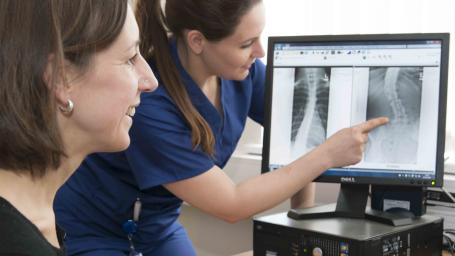A vital branch of our Acute Care Department, the Emergency Department Clinical Research Team deliver national and international multi-centre studies in Emergency Medicine and trauma related specialities, working to advance the care that we give to our patients.
The team also work closely with colleagues across the Trust and beyond to develop new and innovative research ideas that test new treatments especially in the fields of major trauma and emergency medicine.
Please speak to the person treating you to find out if there is a research study that may be able to help you.
Current Studies:
*Severn Major Trauma Network studies
COMITED*
Conservative Management in Traumatic Pneumothoraces in the Emergency Department (CoMiTED): A Randomised Controlled Trial.
Injury is the leading caused of death among adults ages 45 and over. Traumatic pneumothoraces (lung collapse) are present in 1 in 5 victims of severe trauma. In 2019, over 50,000 patients were diagnosed with traumatic pneumothoraces in hospitals in England and Wales. It is a condition that affects not only victims of accidents such as motor vehicle crashes but also a diverse range of underserved groups including young victims of knife crime and older patients who suffer chest injuries after falls.
We estimate from our prior observational and survey work that around half of patients admitted to hospital with traumatic pneumothoraces will be treated with the insertion of a tube into the chest. Current guidelines advise chest drain insertion for any traumatic pneumothorax, although very small pneumothoraces can be managed with observation at the treating physician’s discretion. For some patients with very large pneumothoraces, chest drain placement can reduce the risk of cardiorespiratory compromise. However, there remains a large proportion of patients in whom there is clinical uncertainty as to whether an immediate chest drain is required. Insertion is usually done in the emergency department and is one of the most invasive procedures undertaken outside of an operating theatre. Chest drains carry a high-risk of complications such as bleeding and infection in 15-30% of patients. There is no robust evidence to inform practice, and the default to invasive treatment may cause potentially avoidable patient pain, distress, and complications.
In our analysis of 600 (+) patients with traumatic pneumothoraces from TARN data, 90% of patients treated without a chest drain did not require subsequent intervention, suggesting a potential role for conservative management. However, in this analysis, a remaining 50% of patients were initially treated with a chest drain and there was a considerable clinical variation in those selected for this invasive procedure. We have also conducted an international survey of 222 emergency physicians utilising vignettes of larger traumatic pneumothoraces, and over 60% of clinicians would elect to insert a chest drain in ED, even without clinical compromise.
Therefore, based on the observational studies and lack of robust data, we propose a randomised controlled trial (RCT) to assess the clinical and cost-effectiveness of an initial conservative approach to the management of patients with traumatic pneumothoraces. If we demonstrate that this approach is effective, it will reduce the use of a painful, invasive, and potentially harmful management strategy.
Chief Investigator – Professor Edward Carlton
Principle Investigator – Professor Edward Carlton
SHED – Subarachnoid Haemorrhage in the Emergency Department
Our aim is to understand how best to investigate acute severe headaches, which are suggestive of a condition called subarachnoid haemorrhage (SAH). SAH is a potentially severe cause of headache in the UK and requires urgent identification and treatment. It is defined as the presence of blood within one of the layers of the brain. At its most serious, it can cause death and severe disability.
We want to understand the accuracy of CT brain scanning in the Emergency Department (ED) and how this accuracy changes with time.
We will collect data on patients presenting to the Emergency department that have headaches reaching peak intensity within one hour. These are the classic headache patterns that raise concern with clinicians about the possibility of SAH. We will use this data to try and validate recently proposed clinical rules, and CT brain strategies, which suggest they can exclude the possibility of SAH with a high degree of precision.
With this information, we will be able to inform clinicians how accurate CT brain scans are safely excluding SAH. Further to this, we will highlight how this accuracy changes depending on the timing of the scan, using hourly intervals from onset of the headache. We will also evaluate the accuracy of clinical decision rules (without any brain scans) to exclude the condition of SAH.
Project Details
Principal Investigator: TBC
Planned End Date: TBC
Local Ref: 4761
ASPIRED
Multi-centre open label randomised controlled trial of immediate enhanced ambulatory ECG monitoring versus standard monitoring in acute unexplained syncope patients: The ASPIRED study.
Syncope (or blackout) is common; 650,000 patients present to UK Emergency Departments every year. The 3 underlying causes are vasovagal (simple faint), postural hypertension (blood pressure fall on standing) and cardiac disease. Diagnosis is difficult and is not apparent in 50% of patients after assessment. Whilst vasovagal and postural syncope are relatively benign, serious pathology include dysrhythmia (an abnormal heart rhythm). When cardiac dysrhythmia are detected, they are most commonly asystolic pauses, reflex bradycardia or advanced atrioventricular block, with tachycardia being the minority. The difficulty in the ED is to differentiate between the causes of syncope and identify patients at higher risk. This can be complicated as many patients have fully recovered on ED arrival and their examination and presenting Electrocardiogram (ECG) may both be normal. The lack of efficacy and availability of commonly used monitoring devices means most high and medium risk patients are admitted to hospital for observation and telemetry, with escalating costs. Unfortunately, many still end up being discharged without a diagnosis.
In general, syncope reoccurs in around 50% of patients within a year. Recurring episodes impact upon number of hospital admissions, health costs and importantly the quality of life patients. Whilst there is a wide variation in the literature with respect to the number of syncope episodes and recurrence rates pre and post treatment once a cardiac dysrhythmia diagnosis is made and treatment initiated, around only 10% of patients will have a 1-year recurrence and syncope episodes will drop by over 90%. Pacing, the most specific treatment studied shows a syncopal recurrence rate during follow up of 0-20% versus 20-60% in untreated patients.
The studies primary objective is to determine whether immediate, enhanced ambulatory ECG monitoring decreases the number of self-reported episodes of syncope at one year compared to standard care monitoring in acute unexplained syncope patients.
Chief Investigator – Dr Matt Reed
Principal Investigator – Professor Edward Carlton
BEST-2
The Second Bedside Evaluation of Sensitive Troponin (BEST-2) Study.
Approximately 3% of patients who attend an Emergency Department have chest pain that the clinician who treats them initially suspects may have been caused by an acute coronary syndrome. Most of these patients are admitted to hospital for further investigation, meaning that chest pain is the most common reason for emergency hospital admission. However, tests will later identify that only a minority of those patients has an acute coronary syndrome. If better investigations had been available at the time of arrival in the ED, many of these hospital admissions could have been avoided, which would lead to earlier reassurance for patients and more efficient use of healthcare resources.
It is often difficult to tell quickly if a patient has pain from a heart problem or from something less serious like a muscle strain. At the moment, we rely on testing blood samples in the hospital’s main laboratory for signs of heart damage. It can take up to two hours for the results of each test to be available. If is now possible to do the blood tests for signs of heart damage using small machines that can be used at the bedside. We call these machines ‘point of care’ devices. These devices can usually give results in just 15-20 minutes after taking blood.
In this research study, we want to find out whether the results that we get from such tests are as accurate as the results that we get from the hospital laboratory for diagnosing chest pain related to a heart attack. We hope that this research will enable us to provide faster and better care to patients in the future.
Chief Investigator – Professor Richard Body
Principal Investigator – Professor Edward Carlton
Take Part in Research

Become one of the thousands of people taking part in research every day within the NHS.
About Research & Development

Find out more about our research and how we're working to improve patient care.
Contact Research
Research & Development
North Bristol NHS Trust
Level 3, Learning & Research building
Southmead Hospital
Westbury-on-Trym
Bristol, BS10 5NB
Telephone: 0117 4149330
Email: research@nbt.nhs.uk

